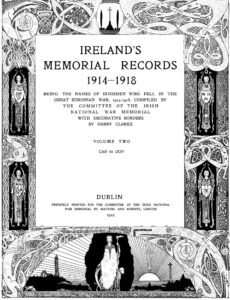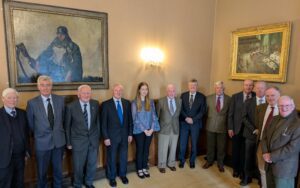Royal British Legion’s Annual Service of Remembrance – Saint Patrick’s Cathedral – 09 November 2025
President Michael D Higgins attended the Annual Service of Remembrance commemorating Ireland’s war dead in The National Cathedral and Collegiate Church of St Patrick, Dublin on Sunday, 09 November, 2025. The Service was his last official engagement as President of Ireland during the last fourteen years.
During the Service, President Higgins and Lieutenant-Colonel Ken Martin, President of the Royal British Legion (Republic of Ireland District), laid wreaths at the War Memorial in the north transept, escorted by Mr Paul Stephenson, Chairman Royal British Legion (Republic of Ireland District).
The Service was led by the Dean, the Very Revd William Morton, and sung by the Cathedral Choir. Lessons were read by Judge John Campbell, Judge of the District Court and Colonel Seán Grant, Defence Attaché British Embassy Dublin.
The exhortation was led by Mr Paul Stephenson, Chairman Royal British Legion (Republic of Ireland District), and was followed by the Last Post, The Silence, Reveille, and the Kohima Epitaph.
The Reverend P.M. Rutherford M.Th., M.A., Chaplain of the Royal British Legion (Republic of Ireland District) formerly Assistant Chaplain General HM Forces preached the sermon.
Attendance included the Deputy Lord-Mayor of Dublin Councillor John Stephens, Minister of State Mr Robert Troy TD representing the Government of Ireland, Ms Verona Murphy, Ceann Comhairle, and Mrs Mary Lou McDonald TD Leader of the Opposition.
Representatives of the Diplomatic Corps included: the British Embassy, Ambassador Kara Owen; Embassy of the United States of America, Ambassador Edward Walsh; Embassy of Australia, Ambassador Chantelle Taylor. Embassy of Canada, Ambassador Dennis King: and Embassy of France, Ambassador Céline Place
Also, in attendance were: Mr Seamus Clarke SC, Council of the Bar of Ireland; Brigadier-General Stephen Ryan, General Officer Commanding 2 Brigade; Deputy Commissioner, Shawana Coxon, An Garda Síochána; Governor Michael O’Mahony, Irish Prison Service; Commander Stuart Armstrong, Naval Service; Commander Tom Wardley RN; and representatives of Veterans Associations and Regimental Associations.
Lieutenant-Colonel Eamonn Fogerty (Retd) represented The Military Heritage of Ireland Trust CLG.
Directors in attendance were: Mr Philip Hamell representing the Leopardstown Park Hospital; Lieutenant-Colonel (Retd) Ken Martin, President Royal British Legion, (Republic of Ireland District); and Brigadier-General Paul Pakenham (Retd) representing the Irish National War Memorial Trust.
Ireland’s Memorial Records

Photograph courtesy of Irish National War Memorial Trust
During the opening procession, the Volume 8 of Ireland’s Memorial Records (sometimes referred to as the Books of Remembrance) was carried, and laid in the north transept. where it remained throughout the Choral Evensong.
During the turbulent years of the War of Independence (1919–1921), and the Civil War (1922–1923), the War Memorial Committee (now styled as The Irish National War Memorial Trust), as an interim project for the War Memorial, focused their endeavors on the compilation, design, and production of a set of bound volumes, titled Ireland’s Memorial Records (sometimes referred to as the Books of Remembrance).
Consisting of eight volumes and 3,200 pages, the names of 49,435 Irish soldiers are recorded, each entry stating the Name, Rank, Unit, Age, Where Born and Location of Death of the individual. Out of the 49,435 soldiers recorded, 30,986 were born in Ireland. The remaining were born elsewhere, with direct family links to Ireland.
The Committee commissioned Henry Clarke for the border decoration. He created seven different designs which were repeated and reversed throughout, together with a front page and a last page, sixteen different arrangements in total. Silhouettes of battle scenes and unit insignia, are mixed with drawings from Celtic mythology.
In 1923, one hundred sets were privately printed by Maunsel and Roberts Limited (Dublin), at a cost of £5,157–14-2, which was drawn from the 1919 War Memorial Fund. The paper used was handmade by the printers. The binding, with grey paper boards and a linen spine, was completed by Galway & Company Binders (Dublin).
At that time, within Ireland, the compilation, production, and distribution of Ireland’s Memorial Records received public commendation, and played a significant role in commemorating those Irishmen who had died in the First World War, many of whom had no grave, and at a time when there was no dedicated national memorial.
Recent research has located thirty-five Irish Memorial Records, fifteen in Ireland, ten in Northern Ireland. and the remainder in England, Scotland, Wales, Belgium, Vatican City, Australia and in the USA (Library of Congress, Washington).
The Irish National War Memorial Trust digitised the Irish Memorial Records in 1995. A digitised version can be viewed in the North East Bookroom of the Irish National War Memorial Gardens in Islandbridge.
During the Royal British Legion (Republic of Ireland) Annual Ceremony of Remembrance and Wreath Laying Ceremony in the Irish National War Memorial Gardens, the eight volumes of Ireland’s Memorial Records held by the Irish National War Memorial Trust (INWMT) are verged, along with the Officiating Clergy, to the War Stone, (also known as the Stone of Remembrance).
Featured photograph courtesy of Patrick Hugh Lynch.
For photographs of the Service please see the associated Flicker Album via the following link:https://flickr.com/photos/mhit/albums/72177720330259994
END




